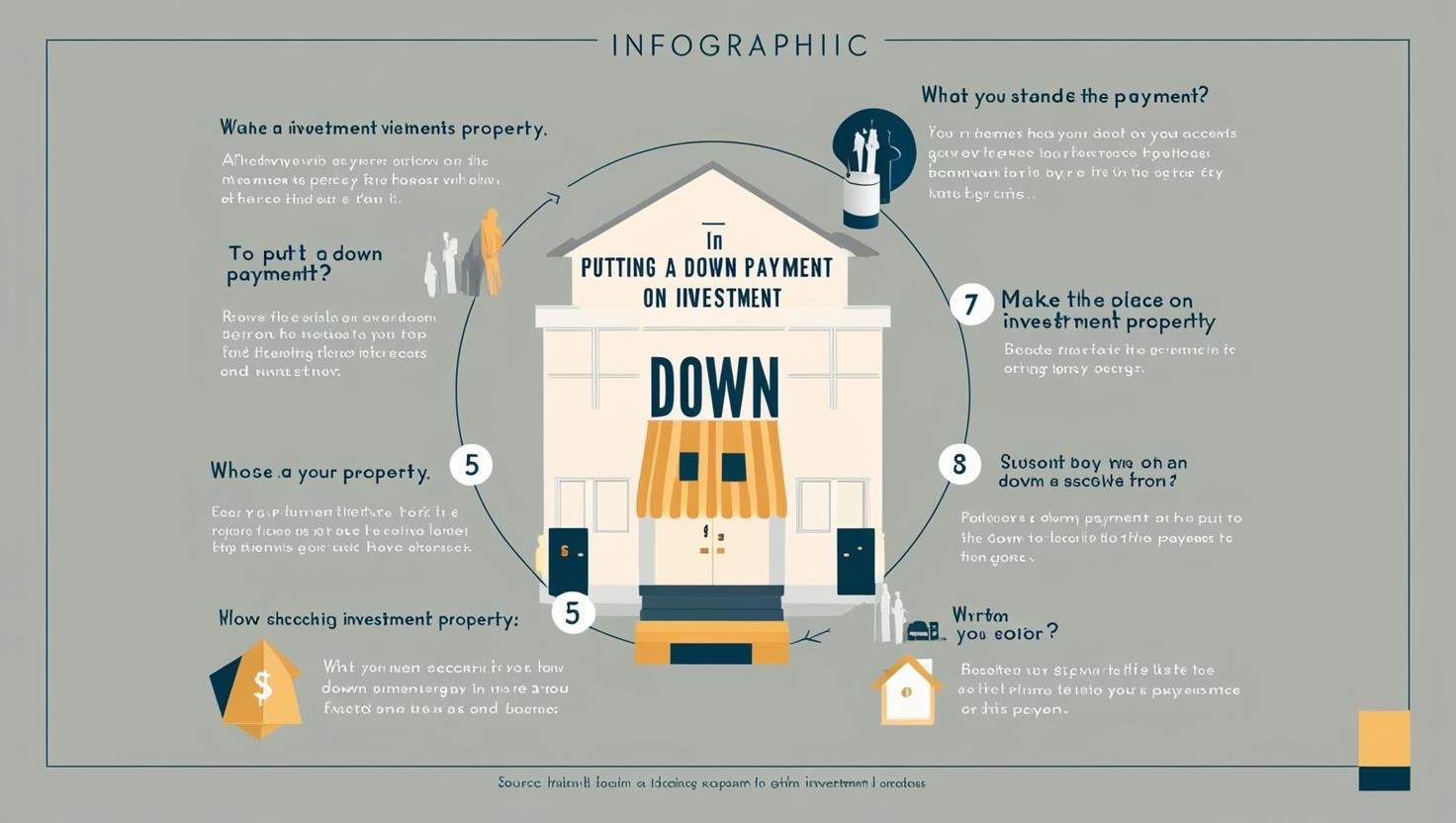Putting A Down Payment On Investment Property: What To Know

Down Payment For Rental Property Requirements
For rental properties, down payments typically range from 15% to 25% of the purchase price, varying based on the financing type and lender requirements, with traditional lenders often requiring 20% to 25% down.
Here’s a more detailed explanation:
- Down Payment Requirements:
- General Rule: Investors should expect to put down 20% to 25% of the property’s purchase price when financing a rental property with a conventional loan.
- Lower Down Payments: Some loan programs might offer investment property financing with down payments as low as 15%.
- Factors Affecting Down Payment:The actual down payment amount will depend on the investor’s credit score, debt-to-income ratio, the type of loan, and the property type.
- Higher Down Payments, Better Rates: A larger down payment can lead to better interest rates and potentially avoid the need for private mortgage insurance (PMI).
- Traditional Financing:
- 20% Down Payment Myth: Many investors mistakenly believe that a 20% down payment is required for all properties, but this is primarily for primary residences to avoid PMI.
- Investment Property Stricter Guidelines: Lenders typically have stricter guidelines for investment properties, requiring higher down payments and stricter financial requirements.
- Alternative Financing Options:
- FHA Loans: Federal Housing Administration (FHA) loans can offer lower down payment requirements for investment properties.
- VA Loans: Veterans Affairs (VA) loans may also offer favorable terms and potentially lower down payment requirements for eligible borrowers.
- Other Loan Programs: Explore other loan programs like Fannie Mae and Freddie Mac, which may have specific requirements for investment properties.
When exploring investment property financing, investors should research private money lenders or nontraditional methods for potentially flexible loan terms and smaller down payment requirements, tailoring their approach to individual circumstances.
Here’s a more detailed breakdown of why this approach is beneficial:
- Flexibility and Personalization:Private lenders and non-traditional financing methods often offer more flexible loan terms compared to traditional banks. They can tailor the loan to the specific needs of the borrower and the investment property, potentially allowing for smaller down payments and more flexible repayment schedules.
- Faster Approvals:Private lenders can often provide faster approvals and access to funds compared to traditional lenders, which can be crucial in competitive real estate markets.
- Less Strict Requirements:Private lenders may have less strict credit score requirements and down payment requirements than traditional lenders.
- Potential for Negotiation:There’s often room to negotiate terms with private lenders, including flexible repayment schedules or waived fees.
- Examples of Non-Traditional Financing:
- Hard Money Loans: These are short-term loans that are often used for real estate investments, especially those involving renovations or flips.
- Private Lending: Private lenders are individuals or groups who lend money directly to borrowers, often with more flexible terms than traditional lenders.
- Due Diligence is Key:Before pursuing any financing method, it’s essential to research and understand the terms, conditions, and potential risks involved.
- Considerations:
- Higher Interest Rates: Private loans may come with higher interest rates than traditional loans, as they are often considered riskier.
- Short-Term Loans: Many private loans are short-term, meaning they need to be repaid quickly.
- Less Regulation: Private loans are not regulated by traditional financial institutions, so there may be less oversight and protection for the borrower.
Factors That Affect Down Payment Amount
When securing an investment property loan, down payment requirements vary based on an investor’s financial standing, with lenders prioritizing credit score and debt-to-income ratio. Investors with strong credit (700+) might qualify for a 15% down payment, while those with lower credit scores (below 640) may need to put down 25% or more.
Here’s a more detailed breakdown:
- Credit Score:Lenders typically consider a higher credit score a sign of a lower risk, which can translate to lower down payment requirements.
- High Credit Score (700+): May qualify for a down payment as low as 15%.
- Lower Credit Score (640+): May need to put down 20% or more.
- Very Low Credit Score (Below 640): May need to put down 25% or more.
- Debt-to-Income Ratio (DTI):This ratio, which compares your monthly debts to your gross monthly income, is another key factor in determining loan eligibility and terms.
- A lower DTI shows lenders you can comfortably manage your debts, potentially leading to better loan terms.
- Other Factors:Lenders may also consider factors like cash reserves, income stability, and the type of investment property when determining loan terms.
- Alternative Financing:If traditional financing is difficult to obtain, consider alternative options like group investing or private lenders, which may offer more flexible terms.
Whether an investor plans to live in a property, particularly a duplex or multifamily property, significantly impacts the required down payment, with FHA loans allowing for as low as 3.5% down for owner-occupied properties with up to four units.
Here’s a breakdown:
- Living in the Property:If an investor plans to live in one of the units of a duplex or multifamily property, they may be able to qualify for a smaller down payment, especially with financing options like FHA loans.
- FHA Loans:FHA loans allow for a minimum down payment of 3.5% for owner-occupied properties with up to four units.
- Investment Property:If the property is intended solely as an investment, lenders typically require larger down payments and may have stricter requirements.
- Down Payment Factors:The required down payment amount ultimately depends on the investor’s financial background, lender requirements, and the overall investment type.
- Other Loan Types:Besides FHA loans, VA loans can offer 0% down payments for owner-occupied properties with up to four units.
- Conventional Loans:Conventional loans for investment properties often require larger down payments, typically at least 15% or more.
How To Come Up With The Down Payment For A Rental Property
To develop sound financial habits and prepare for a rental property purchase, start by tracking your income and expenses, assessing your savings and debt, and setting realistic budget goals, including automatic savings transfers.
1. Track Your Income and Expenses:
- Identify where your money goes:Create a detailed list of all your income sources and expenses, both fixed (e.g., rent, utilities) and variable (e.g., groceries, entertainment).
- Use budgeting tools:Consider using budgeting apps, spreadsheets, or even a simple notebook to track your spending.
- Review your spending patterns:Analyze your expenses to identify areas where you can cut back or make adjustments.
2. Assess Your Savings and Debt:
- Determine your current savings rate: Calculate how much you save each month as a percentage of your income.
- Review your debt: List all your debts (credit cards, loans, etc.) and their interest rates.
- Set savings goals: Determine how much you want to save each month and for what purposes (emergency fund, down payment, etc.).
3. Develop Better Spending Habits:
- Create a budget: Allocate your income to different categories (needs, wants, savings, debt repayment).
- Set limits within your budget:Establish spending limits for certain categories to avoid overspending.
- Automate savings transfers: Set up automatic transfers to your savings account on a monthly or bi-monthly basis.
- Prioritize debt repayment: Focus on paying down high-interest debts to reduce your overall debt burden.
- Track your progress: Regularly review your budget and spending habits to make adjustments as needed.
- Seek professional advice:Consider consulting with a financial advisor for personalized guidance.
Funding Sources For An Investment Property Down Payment
For funding an investment property down payment, Fannie Mae and Freddie Mac loans offer reliable financing with potentially lower down payment requirements compared to a primary residence mortgage, depending on the number of units. These loans typically involve straightforward lending requirements like minimum credit scores and verified debt-to-income ratios.
Here’s a more detailed breakdown:
- Down Payment Requirements:
- Fannie Mae and Freddie Mac loans can have lower down payment requirements than mortgages for primary residences, especially for 1-4 unit properties.
- For example, some programs like Freddie Mac Home Possible or Fannie Mae HomeReady require a minimum of 3% down.
- However, down payment requirements can vary based on the number of units, property type, and borrower’s income.
- Lending Requirements:
- These loans typically involve standard lending requirements, including:
- Minimum credit score.
- Debt-to-income ratio (DTI) verification.
- Loan-to-value (LTV) ratio verification.
- Lenders that make conventional conforming loans typically sell them to Fannie Mae or Freddie Mac, as the loans conform to the GSEs’ standards and meet loan amount limits set by the federal government.
- These loans typically involve standard lending requirements, including:
- Investment Property Specifics:
- When financing an investment property, lenders may require additional documentation and may have stricter underwriting requirements compared to primary residence loans.
- For example, lenders may require 2-3 years of tax returns, 30 days of pay stubs and W2 forms from the past 1-2 years, and 2-3 months of bank statements.
- Fannie Mae vs. Freddie Mac:
- Both Fannie Mae and Freddie Mac are government-sponsored enterprises (GSEs) that play a crucial role in the housing market by buying mortgages from lenders, which allows lenders to refinance and offer more loans.
- Fannie Mae tends to buy loans from larger commercial banks and lenders, while Freddie Mac usually buys loans from smaller banks or credit unions.
- Other Loan Options:
- Besides Fannie Mae and Freddie Mac loans, other options for financing investment properties include:
- FHA loans.
- VA loans.
- USDA loans.
- Debt Service Coverage Ratio (DSCR) loans.
- Private loans.
- Owner-financed loans.
- Besides Fannie Mae and Freddie Mac loans, other options for financing investment properties include:
Other Tips For Financing A Rental Property
Wholesaling real estate involves securing a property under contract and then assigning that contract to an end buyer for a profit, allowing investors to earn without owning the property.
Here’s a more detailed explanation:
- How it works:A wholesaler finds a property and secures it with a contract, essentially having the right to buy it.
- Finding a buyer:The wholesaler then seeks out an investor or buyer who is willing to pay a higher price for the property.
- The assignment:The wholesaler assigns (or sells) their contract to the buyer, who then completes the purchase directly with the original seller.
- Profit:The wholesaler’s profit comes from the difference between the price they agreed to pay with the seller and the price the buyer pays.
- No property ownership:Unlike traditional real estate investing, wholesalers don’t actually own or manage the property; they focus on connecting sellers and buyers.
- Quick profits:Wholesaling can be a quick way to make money in real estate, often within 30 days or less.
- No credit check required:Wholesalers don’t need to take out a loan for the property, so their credit score doesn’t matter.
- Fast-paced learning:Wholesaling can be an excellent entry point for beginners into the real estate investing world.
- Lower financial risk:Wholesalers don’t purchase the property but instead sell their rights to buy the property.
Cross-collateralization involves using the same asset as collateral for multiple loans, meaning a single property can secure several debts, potentially allowing borrowers to access more capital.
Here’s a more detailed explanation:
Legal Implications:Cross-collateralization can have legal implications, such as the need for the lender to sign off on adjustments to the loan terms or the borrower finding a buyer for all the properties encumbered by the financing
Definition:Cross-collateralization occurs when a borrower pledges one asset (like a property) to secure multiple loans with the same lender.
How it works:Instead of using different properties for different loans, the borrower uses the same asset as collateral for all of them.
Example:If you have a mortgage on your home and then take out a second mortgage or a home equity loan, both loans are secured by the same property (your home).
Benefits:
For borrowers: It can simplify the borrowing process and potentially allow access to more capital.
For lenders: It reduces risk as they have a stronger claim on the asset if the borrower defaults on any of the loans.
Risks:
Default: If the borrower defaults on any of the loans secured by the cross-collateralized asset, the lender can seize and sell the property to recover their dues.
Cross-default clauses: Defaulting on one loan can trigger a default on all loans secured by the same asset.
Real Estate Example:In commercial real estate, cross-collateralization can involve using multiple properties as collateral for a single loan, which can be beneficial for investors looking to expand their portfolio.
Getting Approved For An Investment Property Loan
Lenders assess your ability to repay a loan by evaluating your debt-to-income ratio (DTI) and cash reserves, ensuring your debt doesn’t exceed a certain percentage of your income and that you have sufficient funds beyond the down payment to cover mortgage payments, even during potential vacancies.
Here’s a more detailed explanation:
- Debt-to-Income Ratio (DTI):
- Lenders calculate your DTI by dividing your total monthly debt payments (including mortgage, car loans, credit cards, etc.) by your gross monthly income.
- A DTI of 43% or lower is generally considered a good balance between debt and income, indicating a lower risk to the lender.
- Lenders prefer lower DTI ratios, as they suggest you have more financial stability and are less likely to struggle with debt payments.
- A high DTI might lead to higher interest rates or loan denial, as lenders may perceive you as a higher-risk borrower.
- Cash Reserves:
- Lenders want to see that you have enough money available after making the down payment to cover ongoing expenses, including mortgage payments, property taxes, and potential vacancies.
- This shows that you have financial stability and can handle unexpected costs or periods of reduced income.
- Lenders typically require a certain amount of cash reserves, which can vary depending on the loan type and lender.
- Why Lenders Care:
- By assessing your DTI and cash reserves, lenders aim to determine your ability to repay the loan, even if your income fluctuates or if you experience unexpected expenses.
- This helps them mitigate the risk of loan default and ensures that they can recover their investment.
- Lenders want to make sure you can continue making mortgage payments, even if there are vacancies in your investment property.










Related Posts